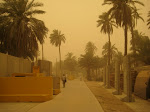

With my arrival in the International Zone, the tendency of the quality of quarters to degrade with my arrival at a new location finally reversed. The IZ is surrounded by numerous residential camps with such inviting names as “The Palms,” “Riverside,” “Poolside,” and “Embassy Suites.” Despite such creative names, all are trailer parks. Still, such trailers are the best quarters in theater.
The day following my arrival, I was assigned a wet trailer, that is, a trailer with an attached bathroom with true running water in the Poolside camp. Such trailers usually house four military or two civilian occupants who share the central bathroom. My side of the trailer measures only 10 x 12 feet, small by terrestrial standards, especially with a roommate, but luxurious and spacious by shipboard standards. The living space features a refrigerator, TV and air conditioner/heater.
After arriving, I quickly received word that my Navy colleagues assigned to nearby Camp Victory (from which I convoyed on the Rhino the night after I arrived at Baghdad) all were assigned dry trailers. Showers and toilets (wet crappers, I’m told) usually range from between 50 to 100 feet away. This makes the four AM visit to the bathroom much more complicated, requiring donning some type of outerwear and some kind of foot ware. In the winter, Camp Victory get notoriously muddy with rain. You get the picture.
Psychologically, it was gratifying to finally unpack with the knowledge I wouldn’t be repacking within a few days and hauling all that gear around. One sea bag and my suitcase were completely unpacked with clothes and uniforms. Two sea bags remain packed with gear I was assigned back at Ft. Jackson and that I won’t be using while assigned to the IZ (e.g., ruck sack, sleeping bag, rain gear, chemical gear, etc.).
When I arrived, I had a roommate, a laconic Army major of the Engineer Corps, who volunteered to come out of retirement for a one year assignment. He wasn’t very talkative and appeared hooked on Soduku puzzles. One night, I went to sleep as he sat on his bed working on a puzzle book and awoke the next morning with him in the same position. He had, of course, gone to sleep. He informed me he was getting ready to go home within the next few days. And after a few, he was packed and gone. It’s been wonderful to have my own room now for two weeks; the IZ is so cramped whenever one goes that it’s gratifying to have a space of my own. I hope it will go on although I imagine I’ll get another roommate eventually.




















